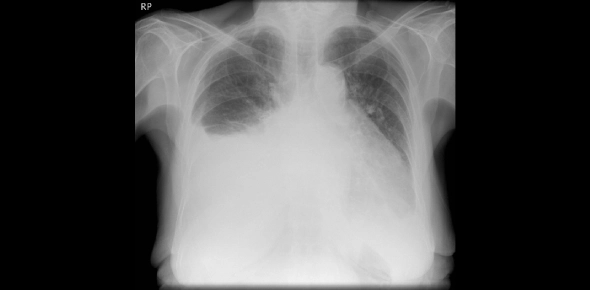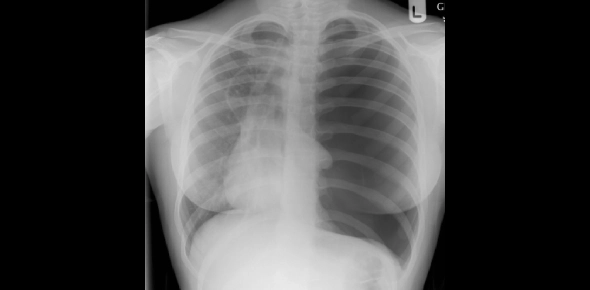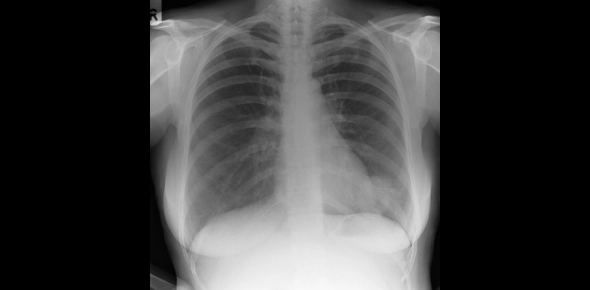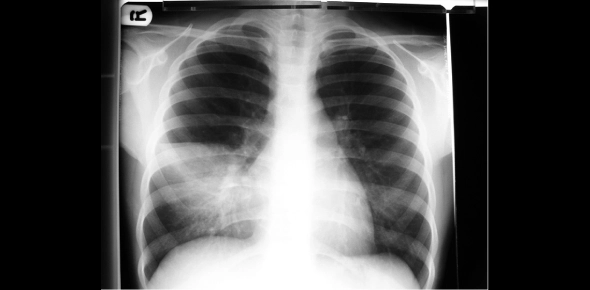What Do You Know About Respiratory Protection? Trivia Quiz

What do you know about respiratory protection? There are a lot of microscopic objects or substances that if ingested either in large or small quantities have an effect on the respiratory system. Most chemical industries require their workers to wear protective equipment to protect themselves from respiratory issues as a result of exposure to certain substances. Do take up the quiz below and get to see how safe you are.
- 1.
You take the history from a 71 year old gentleman who is complaining of breathlessness on exertion. He reports getting very breathless when walking to the corner shop (a distance of around 100 yards), such that he has to stop and 'catch his breath' at least twice en route. He says this has been gradually getting worse over the last 12 months. He has not reported any chest pain at any stage, but does report a chronic cough which is productive of whitish sputum. He states that he thinks he has lost a bit of weight and his appetite 'has never been good.' He has no past medical history of note and takes no regular medication. He has no significant family history and lives alone. He smokes 20 cigarettes per day and has done for over 50 years. He doesn't drink alcohol. He is retired and used to work as a miner. What is the most likely underlying diagnosis
- A.
Heart failure
- B.
Asthma
- C.
Coal-workers pneumoconiosis
- D.
Lung cancer
- E.
COPD
Correct Answer
E. COPDExplanation
Whilst all the above diagnoses are possible (with varying degrees of likelihood), the most likely diagnosis in a smoker with progressive breathlessness is COPD.Rate this question:
-
- 2.
Which of the following are causes of clubbing? (tick all that apply)
- A.
COPD
- B.
Congenital cyanotic heart disease
- C.
Inflammatory bowel disease
- D.
Interstitial lung disease
- E.
Bowel cancer
- F.
Squamous cell lung cancer
- G.
Asthma
- H.
Bronchiectasis
- I.
Pericarditis
- J.
Subacute bacterial endocarditis
Correct Answer(s)
B. Congenital cyanotic heart disease
C. Inflammatory bowel disease
D. Interstitial lung disease
F. Squamous cell lung cancer
H. Bronchiectasis
J. Subacute bacterial endocarditisExplanation
Clubbing is a condition characterized by the enlargement of the fingertips and nails, resulting in a rounded appearance. It is often associated with underlying medical conditions. Congenital cyanotic heart disease, inflammatory bowel disease, interstitial lung disease, squamous cell lung cancer, bronchiectasis, and subacute bacterial endocarditis are all known causes of clubbing.Rate this question:
-
- 3.
A 47 year old woman presents with pleuritic chest pain and breathlessness. Listed below are some of the key features in her history and examination. Identify all that are risk factors for a pulmonary embolism. (Tick all that apply)
- A.
Obese
- B.
History of hypertension
- C.
Total knee replacement 3 weeks ago
- D.
Family history of breast cancer
- E.
Family history of PE
- F.
Being recently post-menopausal
Correct Answer(s)
A. Obese
C. Total knee replacement 3 weeks ago
E. Family history of PEExplanation
Risk factors for venous thromboembolism include:
Venous stasis
Hypercoagulable states
Immobilization
Surgery and trauma
Pregnancy
Oral contraceptives and estrogen replacement
Malignancy
Hereditary factors - family history of DVT/PE
Acute medical illness
Post-menopause is not a risk factor itselft, but if she were taking HRT then that would increase her risk.Rate this question:
-
- 4.
Interpret these pulmonary function tests: FEV1 = 1.56 L (49% predicted) FVC = 1.64L (40% predicted) These demonstrate a restrictive lung defect.
- A.
True
- B.
False
Correct Answer
A. TrueExplanation
The important thing to calculate is the FEV1/FVC ratio, which in this instance is 0.95. If the ratio is normal or raised, then looking at the FVC reveals the answer; If the FVC is normal, then this suggests normal spirometry. In this case the FVC is at 40% of the predicted value for the patient, so is significantly reduced. This demonstrates a restrictive defect.
An obstructive defect would have a reduced FEV1/FVC ratio.Rate this question:
-
- 5.
Interpret the following blood gas: pH 7.29 PCO2 8.2 PO2 8.1 Bicarbonate 32 Base excess - This demonstrates _______
- A.
Respiratory alkalosis and hypoxia
- B.
Respiratory acidosis and hypoxia
- C.
Metabolic alkalosis and hypoxia
- D.
Metabolic acidosis and hypoxia
Correct Answer
B. Respiratory acidosis and hypoxiaExplanation
This blood gas interpretation indicates respiratory acidosis and hypoxia. The pH value of 7.29 suggests acidosis, and the elevated PCO2 levels of 8.2 indicate respiratory acidosis. The low PO2 value of 8.1 indicates hypoxia, which is a condition characterized by low oxygen levels in the blood. The bicarbonate level of 32 is within the normal range and does not play a significant role in determining the acid-base imbalance in this case. Therefore, the correct answer is respiratory acidosis and hypoxia.Rate this question:
-
- 6.
When examining a patient with a pneumothorax, the trachea is displaced __________ the side of the lesion.
Correct Answer
away from, awayExplanation
When examining a patient with a pneumothorax, the trachea is displaced away from the side of the lesion. This is because a pneumothorax is the presence of air in the pleural cavity, causing the lung to collapse. As a result, the affected lung becomes smaller and the trachea is pushed away from the collapsed lung towards the unaffected side. This displacement of the trachea is a characteristic finding in patients with pneumothorax.Rate this question:
- 7.
This chest x ray shows a right sided ___________
Correct Answer
pleural effusionExplanation
The chest x-ray reveals the presence of a pleural effusion on the right side. A pleural effusion is an abnormal accumulation of fluid in the pleural space, the area between the lungs and the chest wall. It can be caused by various conditions such as pneumonia, congestive heart failure, or lung cancer. The x-ray may show blunting of the costophrenic angle, increased opacity in the lower lung fields, and a shift of the mediastinum towards the unaffected side. Treatment depends on the underlying cause and may involve draining the fluid or addressing the primary condition.Rate this question:
- 8.
Which are the following statements is false about this CXR?
- A.
There are reduced lung markings on the right side
- B.
The mediastinum is pushed to the right
- C.
This patient requires urgent treatment
- D.
The treatment includes insertion of a chest drain
Correct Answer
A. There are reduced lung markings on the right sideExplanation
This CXR shows a massive left-sided pneumothorax. It is under tension - this can be assumed from the trachea and mediastinum being pushed across the midline - and this constitutes a medical emergency. In practice, if a tension pneumothorax is suspected it should be immediately decompressed with a large venflon in the 2nd intercostal space, mid clavicular line (on the same side as pneumothorax) BEFORE being x-rayed. This converts the tension pneumothorax into a simple pneumothorax and a chest drain can be then inserted in more controlled circumstances.Rate this question:
-
- 9.
What does this CXR show?
- A.
Pulmonary fibrosis
- B.
Left lower zone mass
- C.
Right apical pneumothorax
- D.
Cardiomegaly
- E.
Pulmonary oedema
Correct Answer
B. Left lower zone massExplanation
The CXR shows a left lower zone mass. This means that there is an abnormality or growth in the lower area of the left lung. The other options, such as pulmonary fibrosis, right apical pneumothorax, cardiomegaly, and pulmonary edema, are not indicated in the CXR.Rate this question:
-
- 10.
What does this CXR show
- A.
Right lower lobe consolidation
- B.
Right middle lobe consolidation
- C.
Right upper lobe consolidation
- D.
Right lung cancer
- E.
Right sided mesothelioma
Correct Answer
B. Right middle lobe consolidationExplanation
This CXR shows a radio-opaque lesion in the right midzone which obscures the right heart border and has a well-defined superior border (due to the horizontal fissure). This would be consistent with right middle lobe consolidation.Rate this question:
-
Quiz Review Timeline +
Our quizzes are rigorously reviewed, monitored and continuously updated by our expert board to maintain accuracy, relevance, and timeliness.
-
Current Version
-
Jul 29, 2024Quiz Edited by
ProProfs Editorial Team -
Aug 22, 2011Quiz Created by
Drbishop
 Back to top
Back to top






